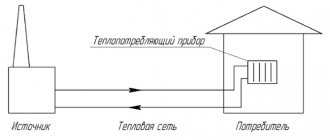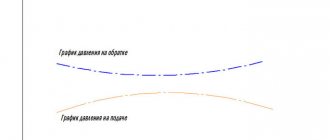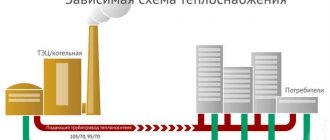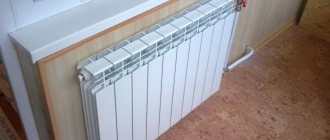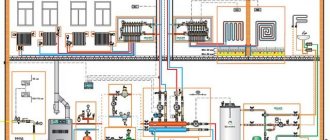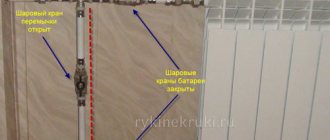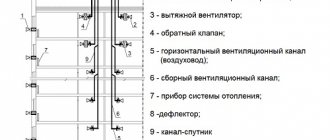To meet the heating needs of residents of high-rise buildings, centralized heating systems are well suited. Centralized heat supply involves the transfer of heated coolant from the boiler room through a network of insulated pipes connected to a multi-story building. Centralized boiler houses have sufficient efficiency and make it possible to combine low operating costs and acceptable efficiency indicators for heat supply to multi-storey buildings.
But in order for the efficiency of the central heating supply to be at the proper level, the heating scheme in an apartment building is drawn up by professionals in their field - heating engineers. The fundamental principles by which a home heating scheme is designed are to achieve maximum heating efficiency with minimal resource consumption.
Contractors and builders are interested in providing apartment owners with a reliable and productive heat supply system, therefore the heating scheme of a multi-storey building is developed taking into account the current cost of heat resources, the thermal output of heating devices, their energy efficiency and the optimal sequence of connection to the circuit.
Individual heating in residential buildings
In addition to central heating, you can find autonomous heating of an apartment in an apartment building; usually such a heat supply is rare and has been installed in new buildings in recent years. Local heat supply systems are also used in the private residential sector. For individual heating in an apartment building, the boiler room is usually located either in the building itself in a separate room or close to the house, since it is necessary to regulate the temperature of the coolant in the heating system.
The cost of autonomous heating in an apartment building is quite high, so it is preferable to commission one powerful boiler house that can provide heat and hot water to a residential neighborhood.
Types of connections
It is not within your power to change the layout of the centralized water circuit, so adjusting the heating system of an apartment building can only be done at the level of your apartment. Undoubtedly, there are situations when, in a single building, residents completely redo the system, but here the so-called “localization” comes into force, and the principles of heating using one or two pipes remain unchanged.
On this page you can also watch a video clip that will help you understand the topic.
Single pipe heating system
- Due to their economy, single-pipe heating systems for apartment buildings have many disadvantages, and the main one is the large heat loss along the route . That is, water in such a circuit is supplied from the bottom up, getting into the radiators in each apartment and giving off heat, because the water cooled in the device returns to the same pipe. The coolant reaches its final destination having already cooled down considerably, so complaints are often heard from residents of the upper floors.
- But sometimes such a system is simplified even more, trying to raise the temperature in the heating radiators, and to do this they are cut directly into the pipe. It turns out that the radiator itself is a continuation of the pipe, as shown in the lower diagram.
- Only the first users benefit from such a connection, and the last apartments get even colder water. In addition, the ability to adjust the radiators is lost, because by reducing the flow in a single battery, you reduce the water flow throughout the entire pipe. It also turns out that during the heating season you will not be able to change the radiator without draining the water from the entire system, so in such cases jumpers are installed that allow you to turn off the device and direct water through them.
- For single-pipe heating systems, the ideal solution would be to arrange the radiators according to size, that is, the first batteries should be the smallest and, gradually increasing, the largest devices should be connected at the end. Such a distribution could solve the problem of uniform heating, but, as you yourself understand, no one will do this. It turns out that saving money on installing a heating circuit results in problems with heat distribution and, as a result, residents’ complaints about the cold in their apartments.
Two-pipe heating system
- A two-pipe heating system in an apartment building can be open or closed, but it allows you to keep the coolant at a certain temperature for radiators of any level . Take a look at the radiator wiring diagram below and you'll see why this is so.
- In a two-pipe heating circuit, the cooled water from the radiator no longer returns to the same pipe, but is discharged into the return channel or “return”. Moreover, it does not matter at all whether the radiator is connected from a riser or from a sun lounger - the main thing is that the temperature of the coolant remains unchanged along the entire path along the supply pipe.
- An important advantage in a two-pipe circuit is the fact that you can regulate each battery separately and even install taps with a thermostat on it to automatically maintain the temperature. Also in such a circuit you can use devices with side and bottom connections, use dead-end and parallel movement of the coolant.
Central heating of apartment buildings
Through main pipelines, coolant from the central boiler room is supplied to the heating unit of an apartment building and is further distributed among the apartments.
In this case, additional adjustment of the degree of hot water supply is carried out directly at the heating point, for which circular pumps are used. This method of supplying coolant to the end consumer is called independent (more details: “Central heating is both pros and cons”). In addition, dependent heating systems are used in apartment buildings. In this case, the coolant is transported to apartment radiators without additional distribution directly from the thermal power plant. In this case, the water temperature is determined regardless of whether it is supplied through a distribution point or directly to consumers.
Types of heating systems in an apartment building can be open or closed (for more details: “Open and closed heating systems - advantages and disadvantages in comparison”).

In the latter option, the coolant from the thermal power plant or central boiler room, after entering the distribution point, is supplied separately to heating radiators and to the hot water supply. In open systems, such a separation is not provided for by the design and heated water for the needs of residents is supplied from the main pipe, so consumers are left without hot water supply outside the heating season, which causes many complaints about utility services.
Features of the upper wiring
Water heating with overhead wiring is used when there is no possibility of laying supply and return lines with coolant in the screed, at floor level or in the basement. This option for supplying the working medium is also in demand when installing a heating system with natural circulation.
The advantages of a heating scheme with overhead wiring include:
- ease of installation . The pipeline can be hidden in ceiling structures or in the attic, which improves the aesthetic perception of communications. When installing coolant lines under the ceiling, you should take into account the placement of furniture, avoiding closing the pipes;
- low heat loss . The heated air in the room rises and compensates for the heat transfer from the pipes, so a significant part of the thermal energy enters the heating devices;
- good hydrodynamic performance . Using axonometry and hydraulic calculation techniques, it is possible to design a heating system with a minimum number of angular turns and branches.
The main disadvantages of a network with overhead wiring are the increased costs of purchasing materials. In addition, there is a need to install more powerful heating equipment due to an increase in the volume of coolant.
Depending on the design features, the network with top supply of the working medium can be single-pipe or double-pipe.
Single pipe heating system
Single-pipe heat supply to an apartment building has a lot of disadvantages, the main one being significant heat losses during the transportation of hot water.
In this circuit, the coolant is supplied from the bottom up, after which it enters the batteries, gives off heat and returns back to the same pipe. Hot water first reaches the end consumers living on the upper floors in a barely warm state. There are cases when a single-pipe system is further simplified, trying to increase the temperature of the coolant in the radiators.
To do this, the battery is cut directly into the pipe. As a result, it seems that the radiator is its continuation. But only the first users of the system receive more heat from such a connection, and the water reaches the last consumers almost cold (about
Requirements and standards for heating an apartment
The heating scheme of an apartment building with centralized heating must guarantee residents that in all rooms the temperature will be maintained at the same level of indicators as specified in the SNiP instructions.
So even in the most severe cold it cannot be below +20 degrees (corner rooms +22), and the humidity should be less than 30-45%. Such indicators are achieved exclusively by the same pressures in the pipes on all floors of the building. For this purpose, preliminary calculations are made and high-quality equipment is installed.
Heating in the apartment (centralized heat supply scheme) operates on water heated to 130-150 degrees when it is supplied to pipes under a pressure of 6-9 atmospheres. With this pressure, steam does not form, since the water reaches the top floor in a matter of minutes, while the return is heated to +60-70 degrees.
Hot water supply in heating systems
DHW in multi-storey buildings is usually centralized, with water heated in boiler rooms.
Hot water supply is connected from heating circuits, both single-pipe and double-pipe. The temperature in the hot water tap in the morning can be warm or cold, depending on the number of main pipes. If there is a single-pipe heating supply to an apartment building with a height of 5 floors, then when you open a hot tap, cold water will flow out of it first within half a minute. The reason lies in the fact that at night, rarely do any residents turn on the hot water tap, and the coolant in the pipes cools down. As a result, there is an overconsumption of unnecessary cooled water, since it is drained directly into the sewer.

Unlike a single-pipe system, in a two-pipe version, hot water circulates continuously, so the above-described problem with hot water does not arise there. True, in some houses, a riser with pipes is looped through the hot water supply system - heated towel rails, which are hot even in the summer heat.
Many consumers are interested in the problem with hot water supply after the heating season has ended. Sometimes hot water disappears for a long time. The fact is that utility services are obliged to comply with the rules for heating apartment buildings, according to which it is necessary to carry out post-heating tests of heat supply systems (pro
Advantages and types of heating network for a house with two mains
The main distinctive feature of this system is the presence of two pipes:
- One of them transports the coolant from the heating boiler to heating devices and registers;
- The second line is needed to remove the cooled liquid and return it to the boiler.
Schematic diagram of the operation of a two-pipe heating system
The advantage that such a two-pipe system has is a uniform supply of coolant with the same temperature to all heating devices.
If a single-pipe line is used, then the coolant has to pass through all pipelines and heating devices sequentially - as a result, the batteries and radiators located at the end of the circuit do not warm up well.
There is an opinion that a two-pipe system requires double the amount of fitting costs (compared to a single-pipe system). But this is not entirely true: a one-pipe system requires the installation of large-diameter pipes, while in a two-pipe main, you can get by with products of a smaller diameter, and accordingly they will cost less. The same applies to fitting sizes - the difference in cost is small.
The small size of the heating elements does not spoil the interior of the room, but if necessary, the pipeline can be mounted (and thus disguised) in building structures. The result is a closed pipeline system.
The location of pipes combined into a single heating network can be done in one of the following ways:
- Horizontal. Such a heating system is usually installed in low-rise, long buildings, for example, a warehouse or a production workshop. The horizontal network is also most often installed in panel-frame buildings, i.e. where there are few or no partitions at all and it is possible to install risers on the staircase or in the corridor. A horizontal network implies constant circulation of coolant.
- Vertical. This method involves connecting heating devices to the main riser installed vertically. The vertical system is used in multi-storey buildings, where each floor is connected separately. A horizontal two-pipe system will cost the homeowner less, but a vertical network creates almost no air pockets, which simplifies its operation.
Radiators for heating systems of high-rise buildings
Cast iron radiators, which have previously been used for decades, are familiar to many residents of multi-storey buildings.
If it is necessary to replace such a heating battery, it is dismantled and a similar one is installed, which is required by the heating system in an apartment building. Such radiators for centralized heating systems are considered the best solution, since they can withstand fairly high pressure without problems. The passport for a cast iron battery indicates two numbers: the first of them indicates the operating pressure, and the second indicates the test (pressure) load. Typically these values are 6/15 or 8/15. The higher the residential building, the greater the operating pressure. In nine-story buildings it reaches 6 atmospheres, so cast iron radiators are suitable for them. But when it is a 22-story building, then for the working functioning of centralized heating systems, 15 atmospheres will be required. In this case, steel or bimetallic heating devices are needed.
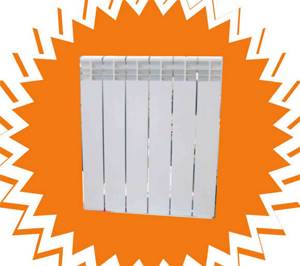
Experts do not recommend using aluminum radiators for central heating - they are not able to withstand the operating condition of the water circuit. Also, professionals advise property owners, when carrying out major renovations in apartments and replacing batteries, to change the coolant distribution pipes to ½ or ¾ inches. Usually they are in poor condition and it is advisable to install ecoplast products instead.
Some types of radiators (steel and bimetallic) have narrower water flows than cast iron products, so they become clogged and subsequently lose power. Therefore, at the point where the coolant is supplied to the battery, a filter should be installed, which is usually mounted in front of the water meter.
Causes of poor coolant circulation
There may be no coolant circulation in the heating system for the following reasons:
- insufficient power of the circulation pump (or pumps, if there are more than one). For this reason, the coolant simply does not reach the radiators furthest from the boiler, so they are cold (or slightly warm, which still doesn’t make it any easier). There are several articles and videos on how to select the power of a circulation pump in the section on heating calculations;
- check valves are not installed. Usually their absence is “painful” for complex systems with several circuits. Check valves are used to ensure that the coolant moves along the desired circuit and in the desired direction (read more below);
- system contamination. It happens that the pipes are clogged along the entire diameter - what kind of circulation is there! There is only one way to treat this: replacing the pipes. This is exactly the case when the best treatment is prevention. And “prevention” should be carried out at the stage of installation of the pipeline and radiators. First, make sure that no debris gets inside the pipes. To do this, after first making sure that there is nothing inside, we close the ends of the pipes with something before installation. For example, it is convenient to use simple plastic bags. Secondly, there may be debris in the radiators. Even new ones! So we check and get rid of it;
- pipe diameter is too small. Small pipe diameter - high hydraulic resistance - the pump is not able to “push” the coolant throughout the pipeline - there is no circulation in the heating system (well, or it is so bad that it’s the same as if it doesn’t exist). Again, at the design stage it is necessary to calculate the hydraulic resistance;
- accumulation of air in the system (airing). Air, of course, is not garbage, but air pockets will also prevent the coolant from circulating freely. Air locks may appear due to violations of the rules for installing the heating system. Getting rid of air is simple - install an automatic air vent at the highest point of the system and Mayevsky valves on the radiators.
The system has many more advantages:
Single pipe system
One pipe can go around the entire perimeter distance along the walls using one closed ring. Already from this pipe you can install radiator batteries, pipes for the “warm floor” system (if necessary), a circulation pump, etc.
- Possibility of installation in apartments and houses of any type and number of floors. This is due to the fact that the supply pipe can even pass under doorways.
- It has lower financial costs due to simple installation and a small amount of equipment used.
- Aesthetics. The main pipe can be hidden under the floor covering so that it is not conspicuous and does not interfere with the overall interior.
- The heating of radiators can be controlled by connecting them in series or parallel to the supply pipe.
- A single-pipe heating system for a one-story house can use two boilers (stove and electric) at once by connecting them in series. This heating method increases its efficiency, reliability, and also the cost-effectiveness of its operation. So, in the event of a power outage, the house can be heated using any other boiler.
- You can direct the flow of water or other liquid used in the system in the desired direction. The system allows you to direct the movement of hot liquid to the coldest rooms of the house.
System layout
The wiring of a one-pipe heating system can be with closing circuits or flow-through. In the first case, heating occurs by dividing the flow of heated liquid into two parts. One part will go directly into the radiator battery, and the second will continue its path along the riser. The first part of the water passing through the radiator will enter the general flow and will be slightly lower in the next radiator.
Installation of a one-pipe system
Heating with a closing circuit separates the flow of coolant by using fittings with a bypass. And the valve already regulates the flow ratio.
With a flow-through single-pipe system, the coolant passes sequentially to all heating elements, gradually losing its heating temperature.

